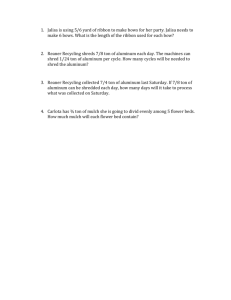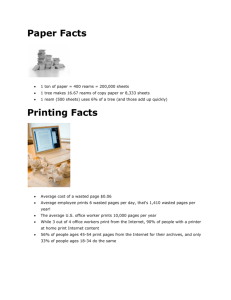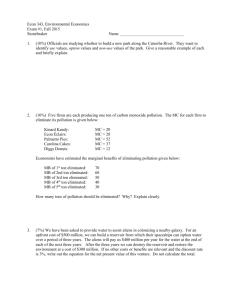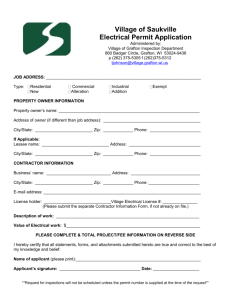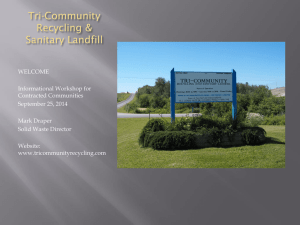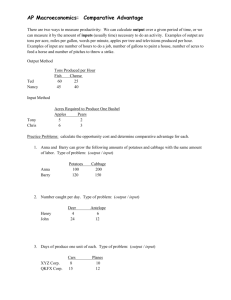Slatina-Timi* Case Study How can some communities be healthier
advertisement
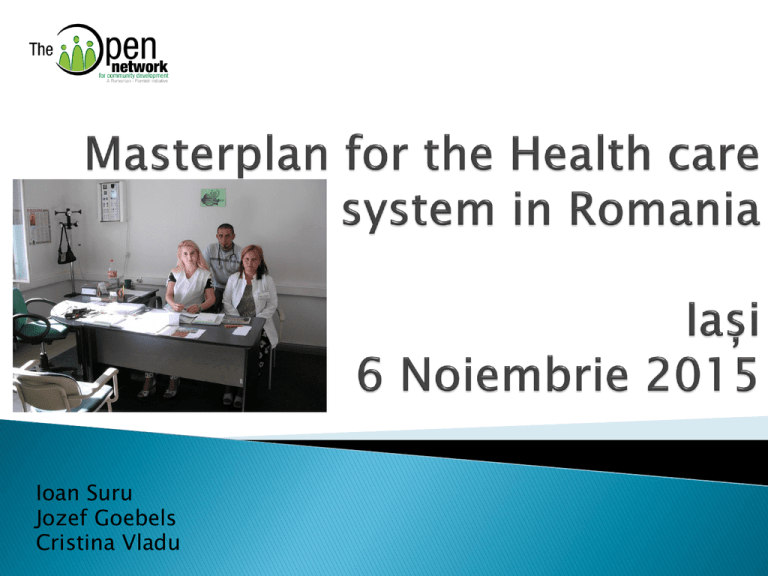
Ioan Suru Jozef Goebels Cristina Vladu I. TON Health MasterplanSWOTAR Strong partnerships between Romanian and Belgian communities with more than 25 years of existence; Civic groups initiated in target communities: women- / men- / youth- / elderly organizations, Vizidom, etc. A number of Local Health Committees created, having implemented or having expressed willingness to promote innovative health care services within their communities (Slatina-Timiș, Tăut, Moldovita, Viscri, others). Some of the Health Committees – as in Slatina-Timiș and Moldovița- have constituted formal organizational structures with juridical personality such as ADAM (Associația De Ajutor Mutual); More than that, the ADAM (community health center) in Slatina-Timiș having more than 15 years of continuous activity started to be able to report better health of its citizens. Low capacity in basic health services provision at community level in general (low level of specialized staff provided under public arrangements); Low overall funding of the health care system in Romania; with an overall budget of around 3,6- 4% of the GDP allocated to the health care system, Romania places itself near Bulgaria, on the last places in the European Union; Lack of information at community level about basic health status of the population; Low institutional capacity/ weak governance structures of the Local Health Committees; Low coverage with human resources both in terms of numbers as well as in terms of the range of specialties involved. Lack of interest from local governments. Simple health care services that are not currently provided can enable high levels of health gain for the specific communities, hence, small investments can lead to high benefits in terms of health of the community members; Documentation and promotion of the successful case study in SlatinaTimiș can represent an engine for an advocacy strategy developed by TON in favor of health policies better adjusted to the needs of rural communities; The 2014-2020 National Health Strategy of Romania (approved by Government Decision in November 2014) does emphasize the need to enable better access to basic services for most vulnerable populations; Good potential of shared fundraising/advocacy; TON will develop knowhow to increase performance and coverage of health services at Romanian community level, ADR would support with the identification of Belgium partners; shared projects (fundraising) and shared learning would become beneficial for both TON and ADR; projects written and implemented in partnership will have better chances of success, higher chances for advocating for the solutions that prove to be of good benefit for the health of citizens in rural communities; Permanent exchange between B-Ro specialists in different matters. The underdeveloped health services at community level (i.e. the low level of prevention services that practically condemn the population to become unhealthy very early during life course); The population aging / increase of dependency ratio The upcoming private health insurance that will introduce fees established according to the level of the risk of each individual shall put individual in rural isolated communities at much more health risk than other citizens of Romania. Doing nothing represents an enormous threat to the health of citizens in rural communities in general and to the chronic patients living in rural areas in particular. This will automatically lead to more expenses as well for the patients as for the state budget. To develop TON as a reference organization concerning local healthcare, improved access and equity to health care for rural population; To improve the health status of citizens in at least 20 TON communities; To identify and to contribute to innovative solutions for better services in rural areas; To increase TON institutional capacity for health at national level; To increase TON institutional capacity for health at local community level; To implement and monitor new services in TON communities. To develop TON will contribute to better health of the population by becoming a strong advocate for better healthcare services. TON Master plan healthcare is Implemented by 2025; 20 local health action plans are developed and implemented by 2025; 10 community healthcare centers (ADAM’s) are functioning by 2025; 10 local health committees (LHC) are functioning by 2025 ; Monitoring reports are issued quarterly by each of the 20 communities implementing action plans; 10 monitoring reports / socio-medical maps have been developed; At least 3 community health projects have been implemented in each of the 20 TON local communities; At least 40 training and educational programs have been provided for health professionals working in the new projects; At least 10 trainings have been provided to TON facilitators; Guidelines for setting up local health projects have been defined. II. Objectives of the Health Masterplan To improve the health status of citizens in the 20 TON communities during the next 10 years (to achieve better trends of major health indicators as compared to the national trends of the health indicators). SO1. To increase TON institutional capacity for health at national level SO2. To increase institutional capacity at local community level and create 10 ADAMs/or grass root organizations with juridical personality and 10 Local Health Committees (LHC) in 20 of the TON communities. SO3. To effectively implement and monitor at least 60 new services within the 20 TON communities (at least 3 new services per community). III. Health masterplan Menu of projects Inputs TON creates partnership with leader organizations providing services in the area- SMURD/ Flemish partners; TOT program for professionals / volunteers from TON communities, including guidelines/ manual for good practice- provided by SMURD/ Flemish experts; Existing materials Be / Switzerland and new approach ministry of Internal affairs on safety (master plan for 10 years – communication with Mr. Arafat); BIG (Brandweer Informatiecentrum Gevaarlijke stoffen, Belgium) Fire-fighters Information Centre Dangerous Goods. Expected Outputs 15 TON professionals/ volunteers per each TON community are trained under a TOT program by SMURD/ Flemish partners; 100 youth (from Youth group) / children are trained in each TON community; Preparedness exercises in case of emergency are tested yearly in participating TON communities; Dissemination / advocacy strategy defined for recognition of the volunteer fire fighter/ the integration of his/her intervention within the intervention protocols; Communication and warning systems for volunteer firefighters / Personal insurance for volunteer firefighters / yearly medical check-up by ADAM for free. Inputs TON creates partnership with leader organizations providing services in the area- World Vision Romania / National Center for Studies in Family Medicine, the General Directorate for Child Protection, etc.; Professionals from TON communities follow a minimum training program (training to be provided by experts of the National Center for Studies in Family Medicine). Belgian partners: Kind en Gezin, CM, SM, to be confirmed. Expected Outputs At least 10 persons are trained at the level of each TON community (Task force members/ professional team/ social worker/ volunteers) in mother and child health; Selected / specific indicators are identified; Monthly monitoring electronic reports are issued/ overall TON communities map of indicators. Inputs Mapping of TBC patients in the community; Training for community nurses, family doctors for the proactive monitoring of TBC patients, TBC contacts and suspects; Vertical integration with specialized services. Expected Outputs Number of patients correctly taking the treatment; Number of contacts that are adequately investigated. Inputs Health education trainings for health professionals (community nurses, family doctors) and community members over hepatitis C transmission; Basic screening for liver malfunction; Training on diseases care planning, treatment guidelines, vertical integration between PHC and specialized services. Expected Outputs Number of new cases with Hepatitis C identified; Number of patients with hepatitis C appropriately treated. Inputs TON creates partnership with interested stakeholders Trainings to task forces and professionals in TON communities; Small grants for schools and kindergartens (standard packages with balls/ ropes/ Frisbees / bikes, etc.); Cooperation with DSP; evidence based activities such as food triangle and actions in schools together with parents in order to get healthy food to be incorporated in lessons; Cooperation with AGLT / play days / Youth Organizations Flanders (Somepro); Monitoring and evaluation of activities and reporting to local councils, DSP. Expected Outputs At least 80% of the schools and kindergartens in the20 TON communities enroll to the program and foresee these activities within their Rule for Internal Organization; At least 75% of children 03-18 year old have access to prevention of NCDs in TON communities; At least 50% of parents of children 03-18 years old have access to prevention of NCDs activities in TON communities; Activation and cooperation with parent organizations in schools. Inputs TON creates partnerships with the Center for Studies in Family Medicine for provision of the needed training/ coaching of health workers teams in diagnosing / managing risks for diabetes/ hypertension/ alcohol or tobacco consumption; TON will develop a ‘diabetes passport’ and a ‘diabetes daily registration notebook’ for insulin dependent patients, others every 3 months; TON will look for a project installing a ‘Green Diabetes Phone line’ where all kind of information regarding diabetes can be asked. Dial in for free; Common purchase of products: i.e. lancets for glucose meters, glucose meters, etc. will be examined. Expected Outputs 75% of the community members at risks of NCDs are trained to become aware of their risks, to acquire knowledge, skills and attitudes to be able to control their risks; Cooperation with the Romanian diabetes organizations and federations as well with the Flemish diabetes league and the international diabetes federation IDF will be set up. Inputs Partnerships with medical doctors associations of diabetes specialist doctors and cardiologists (Romanian Society of Hypertension) to enable dissemination loops starting from the actual examples in communities; Training of professionals/ task force members; Access to ECG in each community medical center; Blood pressure meters in community medical centers that can be lend to patients for a week for monitoring the blood pressure; mediate for common purchase to reduce prices for good quality; Preventive checkup for diabetes; definition of specific plans for the different risk groups. Expected Outputs Health staff is trained to apply evidence based guideline for DZ/HTA treatment, implement correctly disease management plan; More than 75% of patients of DZ type II / HTA are trained to understand importance of treatment/ life style. Inputs Partnership with the Association of Social Psychiatry/ Psychiatric hospital in Câmpulung Moldovenesc/ Estuar Foundation; Training provided to health workers/ social workers in TON communities around Câmpulung Moldovenesc; Cooperation with OPZ (Public Psychiatric Hospital Geel, Belgium), Emmaus group Belgium, and Mutualities, to be confirmed. Define a practice community mental health model based on placing and monitoring the patient within Foster Families. Expected Outputs Family Doctors/ social workers/ community nurses/ volunteers team (at least 10 members) trained /working procedures for approaching patients with mental health problems agreed amongst professionals for most frequent conditions. Inputs Training providers/ training of community home care teams; Cooperation with White-Yellow Cross Belgium, Crucea Alb-Galbenă Romania, SeniorNet, Caritas; Develop renting services for revalidation materials in TON communities; Develop a system of providing hearing aids to TON members in cooperation with specialists; Develop a system of providing reading glasses to TON members in cooperation with specialists; Test adding the “Meals on wheels” services together with home care services Develop the system of ‘TON social fund’ locally. Expected Outputs At least 10 of the 20 TON communities that have achieved juridical personality (ADAM) will also achieve accreditation status allowing for the provision of home care services; At least 7-10 persons trained in each community for home care services provision; At least 50% of the persons in need for home care in the community do benefit from services; Advocacy campaigns with other home care providers for appropriate funding of home care services (i.e. funding for chronic home care and not merely home care for discharged patients). Inputs Partnership with expert organization- Hospice Casa Speranței; Pre-existence of networks of professionals in the area/ other types of services such as home care; Funding secured for initial training; System of Vizidom within TON network; Belgium partners. Expected Outputs 100% coverage of terminal patients with palliative services in TON communities. Inputs Training programs for community health staff, information sessions, and sessions of practice analysis/ scheduling of lab tests, etc.; Screening tools (BIOCARTIS: Biocartis aims to provide direct access to personalized medicine for patients worldwide by developing fully integrated and broadly applicable molecular diagnostics. Their platforms can be used in a wide variety of healthcare settings to enable rapid and high-quality care close to patients.); Provision of correct and adequate Information to people. Expected Outputs Systematic referral of eligible population to organized cancer screening programs- at least 75%of eligible population. Inputs Refurbished dentists cabinets with needed equipment; Contracts with medical dentists for services provision at rural community level; Contract with CJAS (health insurance) gives access to free preventive activities for children; Support to prevention services/ provision of tooth brushes, tooth paste with Fluor; Training in modern techniques/ prevention techniques of the staff of the dental cabinet; Lobby for enabling the implementation of practice assignments for Final year dental care students; they would practice on real patients in order to learn basic practice skills and ‘behavior management’. Belgian partners with know how in evidence based preventive practices in dental care; Trainings in oral hygiene/ prevention/ access to prevention techniques for children/ youth/ and their parents. Expected Outputs Number of children / youth having had access to dental prevention services; Number of dental care patients treated at community level. Inputs Training of pharmacists / nurses working in community pharmacies in provision of information to patients; Access to subsidized essential drugs is ensured; Introduce the IMV (Individual Medication Preparation) system by which surpluses medication can be removed trough a pill-by-pill delivery. Expected Outputs Increased number of patients with appropriate treatment. Inputs Case study ADAM Slatina-Timiș; Cooperation with Belgian Mutualities; Trainings, examples of bylaws, coaching during general assembly meetings; coaching on how to manage the budget within an ADAM; PR campaign to “sell” the benefits of mutualities to be developed within the pilot communities. Expected Outputs ADAM mutual structures defined in at least 10 more TON communities; Populations in pilot communities start paying contributions. Homecare shops / health promotion shops; LOGO (prevention – health promotion in Flanders) and DSP in Romania. Working on a ‘Healthy Commune Charter’ for TON communities (kind of label) to promote healthy lifestyle through different activities such as: healthy nutrition, leisure time, culture, sport, environment, etc. and try to be a network for these different domains and actions ; Internships (social students, nurses, etc.). Erasmus contracts: VGU Arad / University Resita: look here also for trainings centers for TON; European e-health training portal. Image toolkit; Develop good ICT systems in which patients can be followed and registered; Online trainings with available tutorials in future. Telemedicine projects. TON secured FDSC funding for implementing 5 home care projects in Moldovita, Viscri, Taut, Dumitresti, Caras. Project includes: Support in creation of organizational structures Start up funding for home care nurses Initial provision of home care services Support in accrediting the new organizational structures and contracting services through public funds THANK YOU FOR YOUR ATTENTION! Cristina Vladu, TON Expert on health care cristina.vladu@theopennetwork.ro IoanSuru, coordinator ADAMSlatina-Timis mutualite_csro@yahoo.com JozefGoebels, TON President jozef.goebels@med.kuleuven.be

